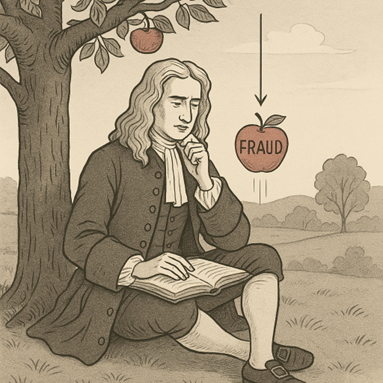Newton, Force Fields, and Fraud: A New Way to Understand Dishonesty
- Jul 20
- 3 min read
At first glance, Isaac Newton might seem to have nothing to do with fraud. But when we consider how his laws of motion and gravity explain the balance of forces in physical systems, a compelling metaphor emerges. Just as engineers must understand and manage the multitude of forces acting on a building to prevent collapse, fraud investigators and policymakers must understand the social, psychological, and procedural forces that influence dishonest behaviour.

From Gravity to Greed: Rethinking Fraud Through Newtonian Metaphors
In classical mechanics, an apple falls due to gravity until it meets an equal and opposite force from the ground. Similarly, buildings are subject to a dynamic interplay of forces -gravity, wind, heat, human activity - that must be balanced to maintain structural integrity. This concept of force equilibrium is mirrored in classical criminology, which uses both physical and psychological deterrents - prison, police presence, handcuffs - to maintain social order and prevent crime. But fraud is typically secret, silent, invisible and a very low police priority. So, the traditional prevention and deterrence forces are ineffective in resisting the complex mix of forces that drives fraud.
The fraud triangle is based on three factors (i.e. forces): financial pressure, opportunity, and rationalisation. Over time, this model has expanded into polygons like the fraud heptagon, adding traits such as capability, arrogance, ignorance, and greed. However, for fraud prevention purposes, these offender-focused models have limitations:
They’re hard to observe – personal circumstances, attitudes and psychological traits aren’t easily observable.
They’re not universally applicable - not all personal factors apply in every case.
They ignore environmental factors - like local culture and the effectiveness of management controls.
Introducing the Fraud Field: A Dynamic Systems Approach to Dishonesty
To address these gaps, Button et al. introduced the concept of the fraud field—a dynamic model that can be tailored to any specific environment. Unlike the polygons, it is not prescriptive in specifying which forces are present in any situation. It proposes that fraud occurs when threat forces (e.g., the number of fraudsters, enablers, and opportunities) outweigh safeguarding forces (e.g., deterrence, culture, controls).

A case study illustrates this. In the purchasing department of “Westshire Council,” lax controls over its overly complex procedures give rise to a high rate of bureaucratic errors and encourages work-arounds. This creates a fertile ground for perpetrating and hiding fraud. A procurement officer exploits the system with a supplier, emboldened by the low risk of detection. As colleagues observe his success and the lack of consequences, they follow suit, increasing the fraud rate. Eventually, the somnolent management notices and quietly dismisses the offenders.
This scenario demonstrates the fraud field principles:
Fraud happens when threat forces exceed safeguards.
Increasing threat forces raises the fraud rate.
Increasing safeguards reduces it.
Any change in force shifts the fraud rate to a new equilibrium rate.
The fraud field model encourages a strategic, systems-based approach. For example, in Westshire Council, a counter-fraud strategy might include:
Increasing deterrence through prosecutions.
Simplifying procedures to reduce errors and work-arounds.
Strengthening controls to limit opportunities.
Engaging ethical suppliers by contractually obliging them to report fraud.
Replacing ineffective managers to improve oversight.
The Power of Adaptability: Visualizing and Managing Fraud Forces
Unlike rigid offender polygons, the fraud field is adaptable. It can incorporate any number of forces, organised into sub-fields as needed. It also allows for visual mapping of the current situation, proposed changes, and post-intervention outcomes. Even resistance to anti-fraud measures can be treated as a force within the model.
The fraud field is not a magic solution but a structured, dynamic way of thinking about fraud. It shifts the focus from individual psychology and personal circumstances to the broader system of interacting forces, offering a more holistic and actionable framework for prevention and control.



Comments